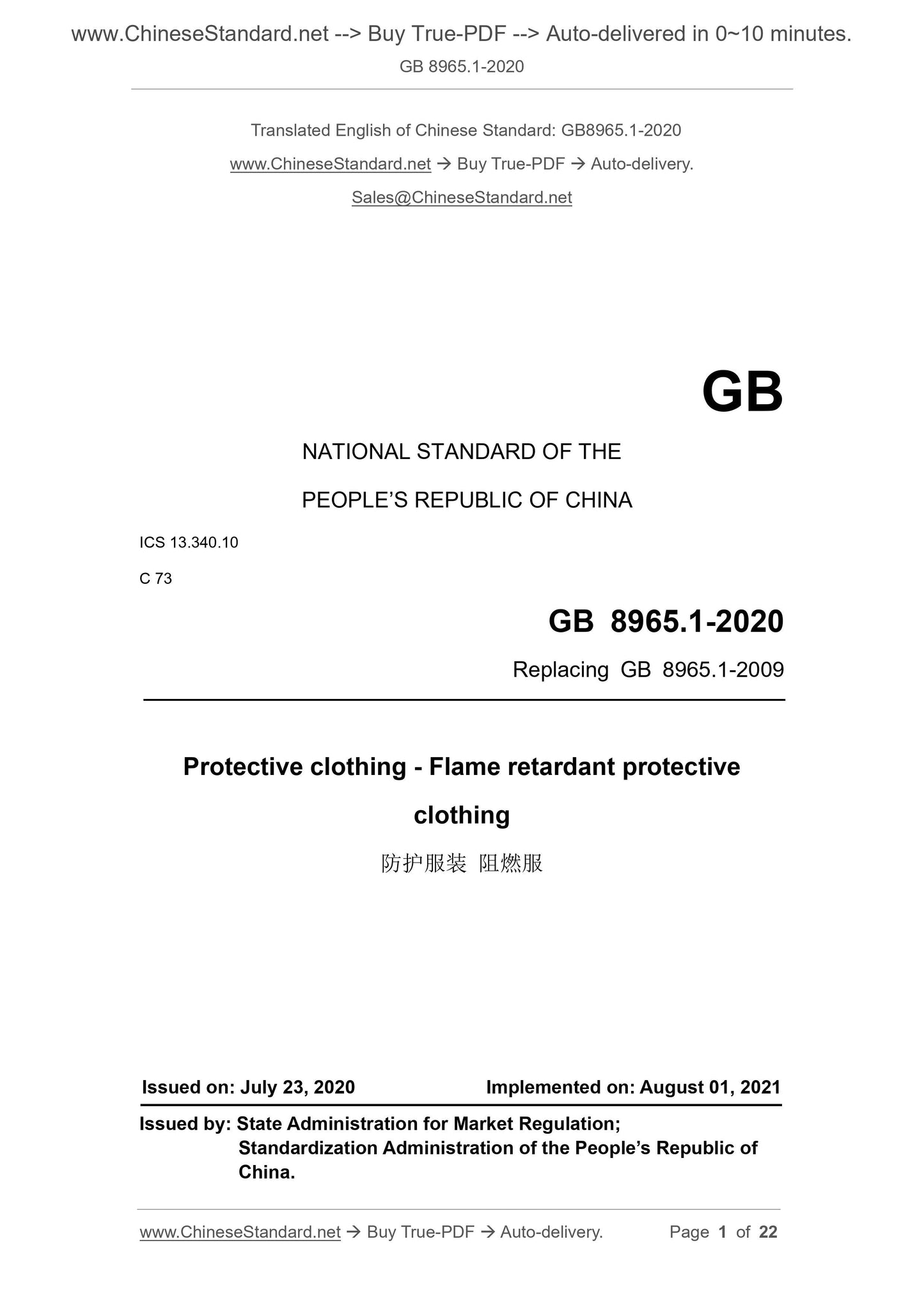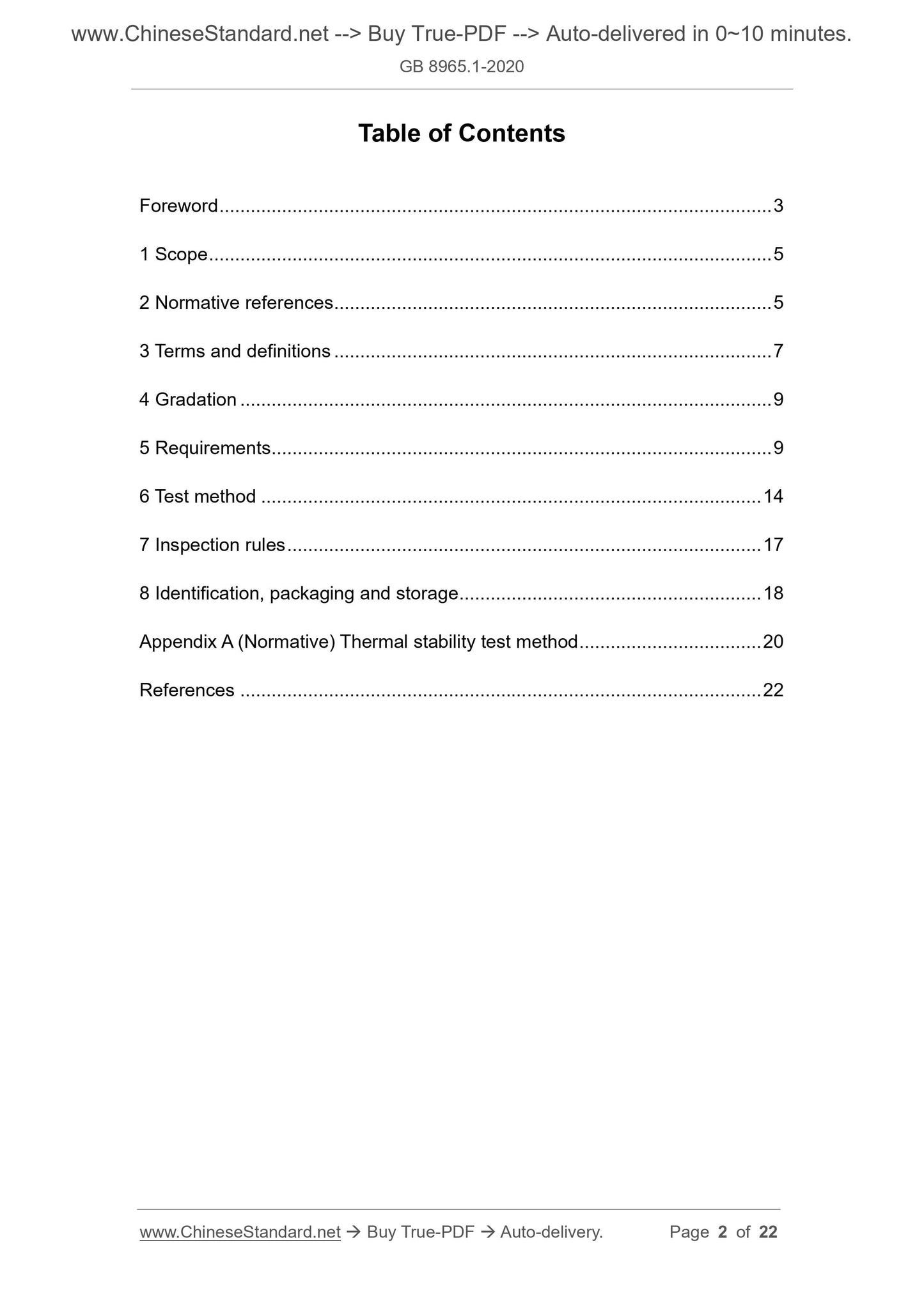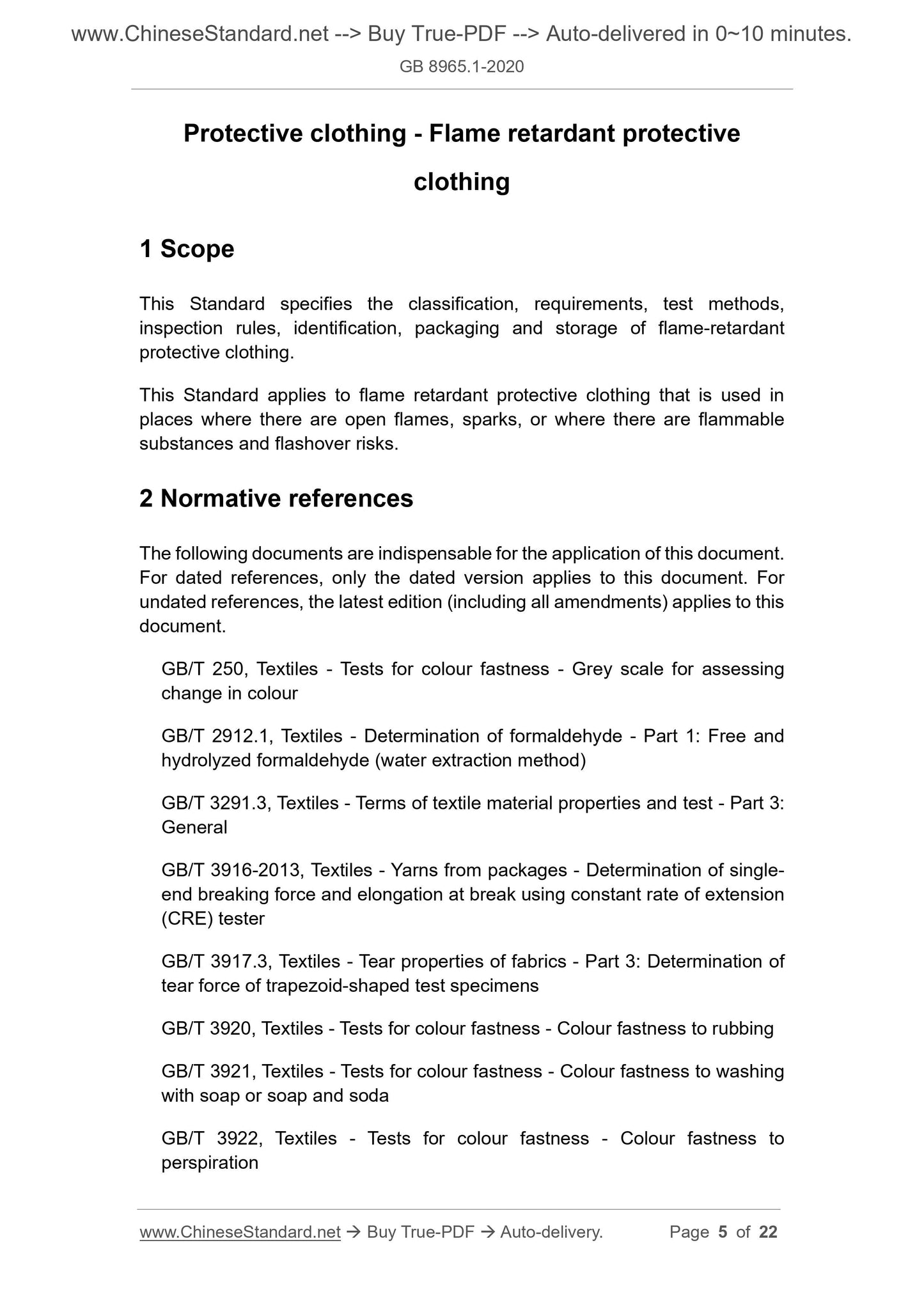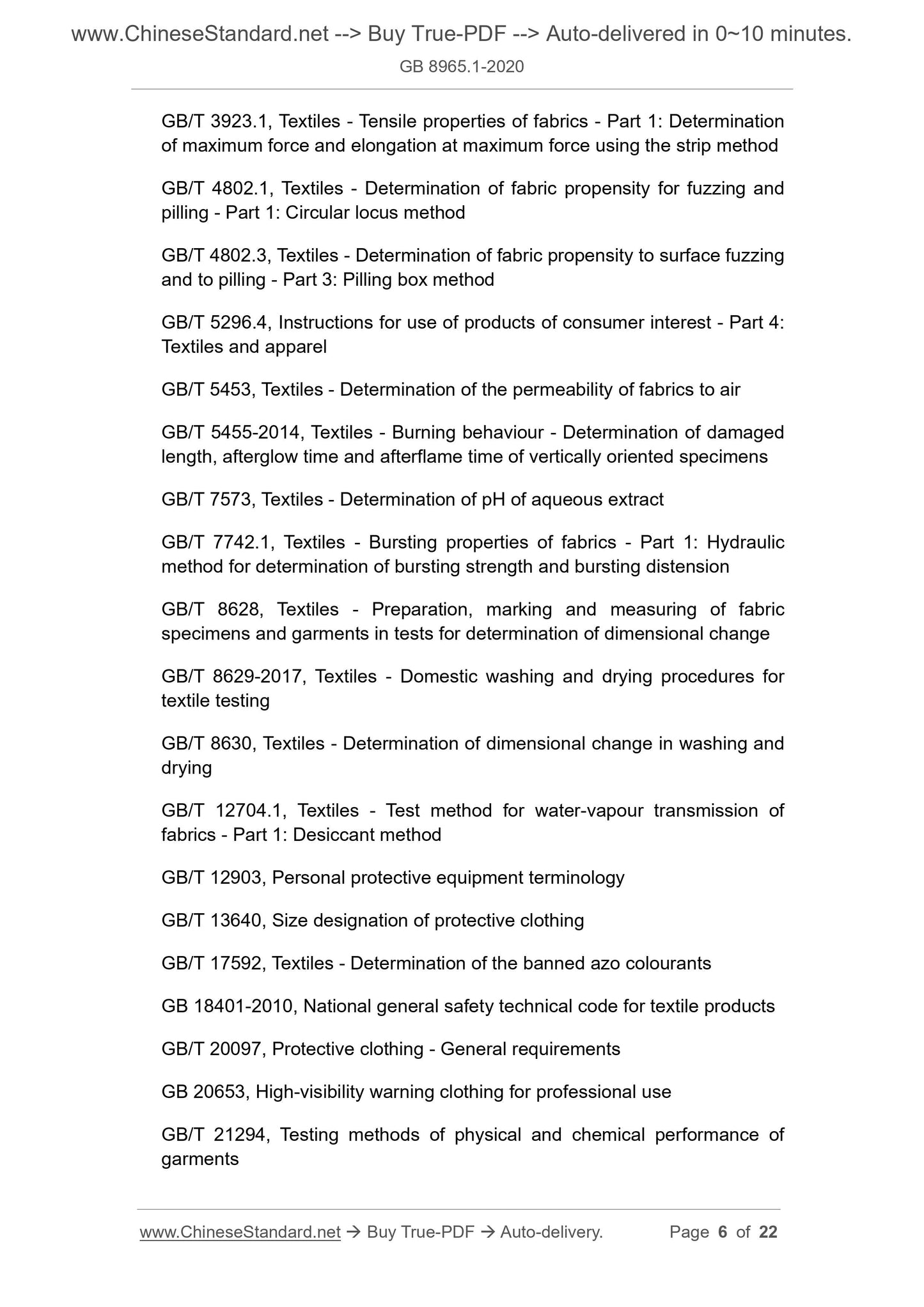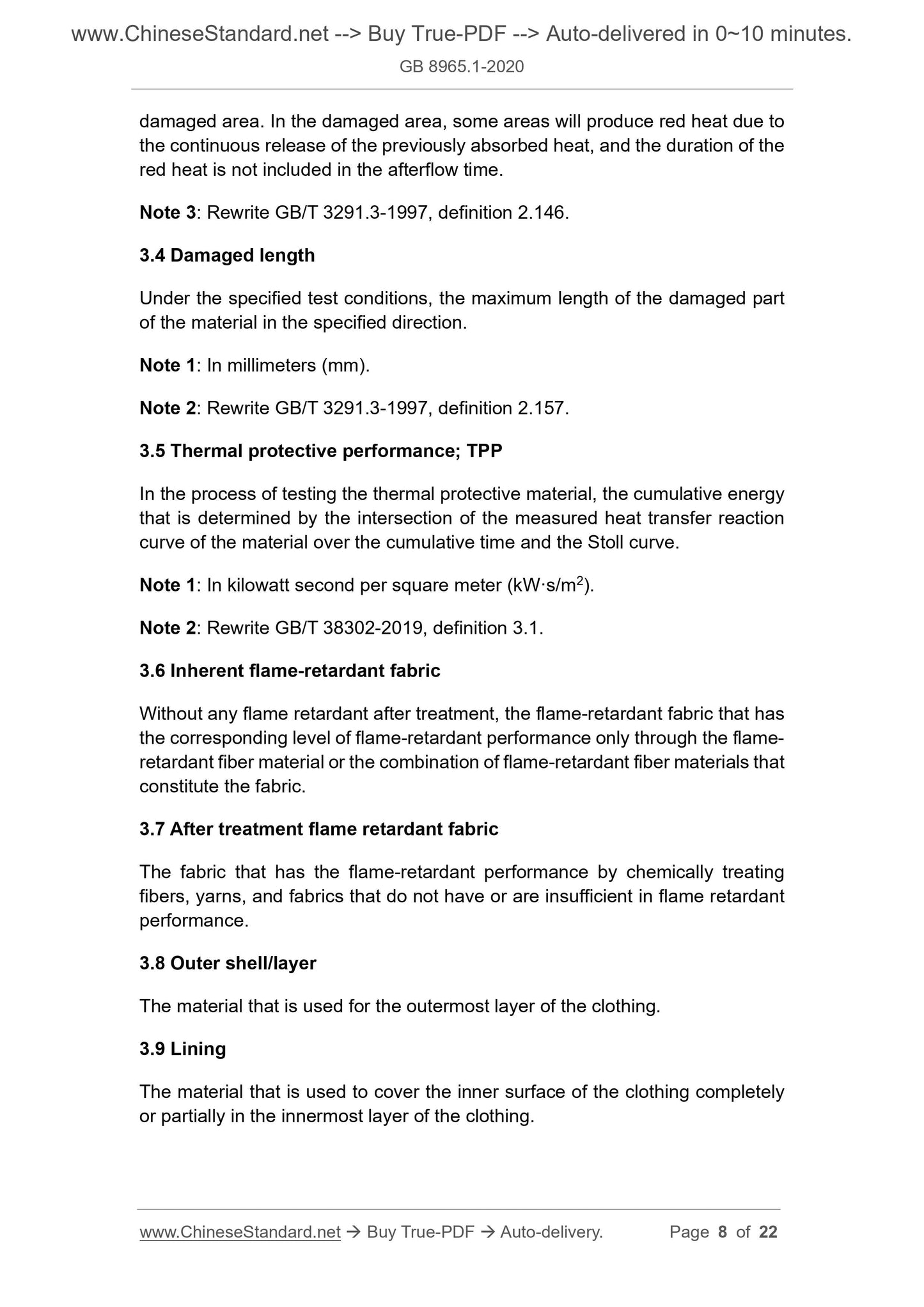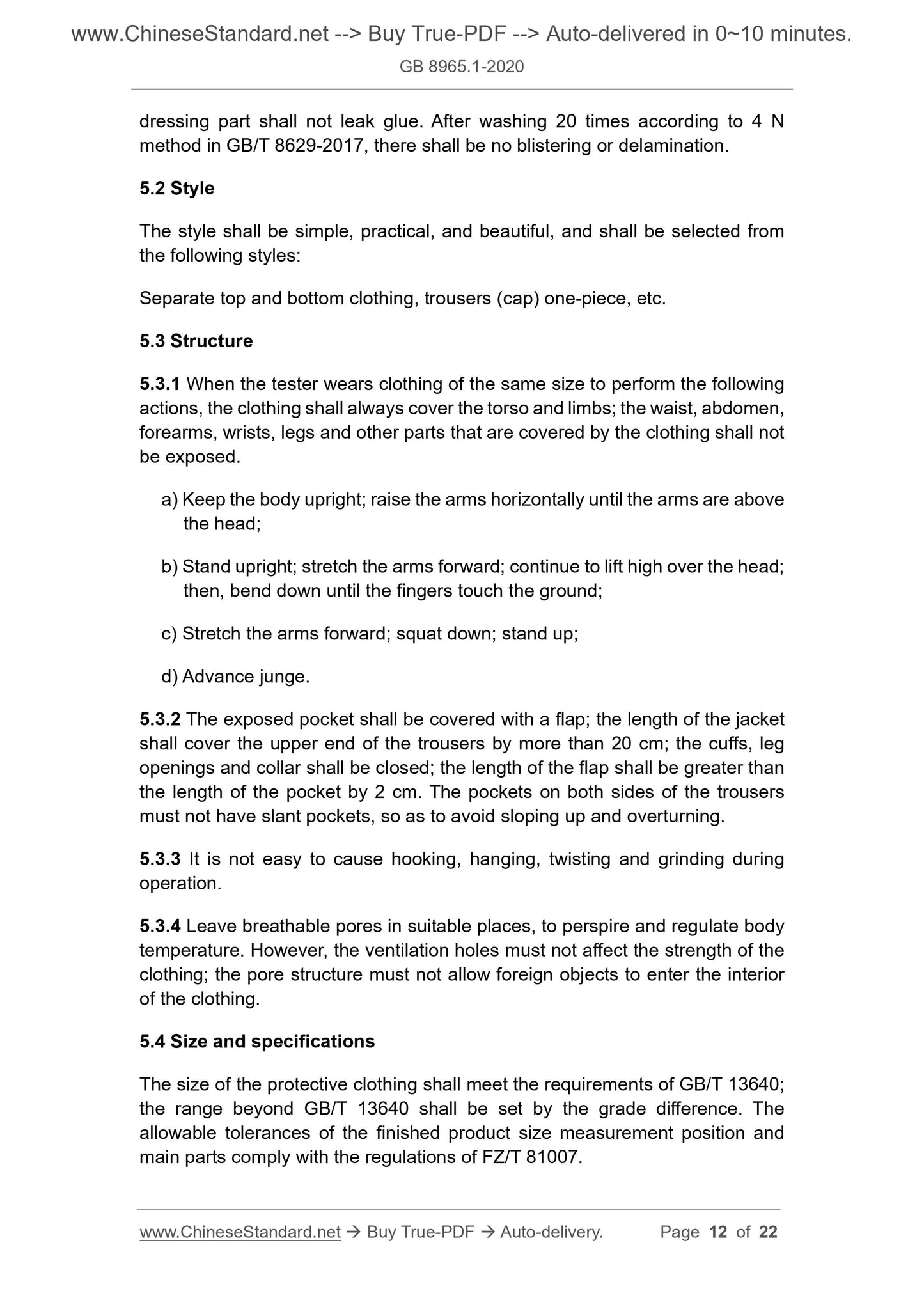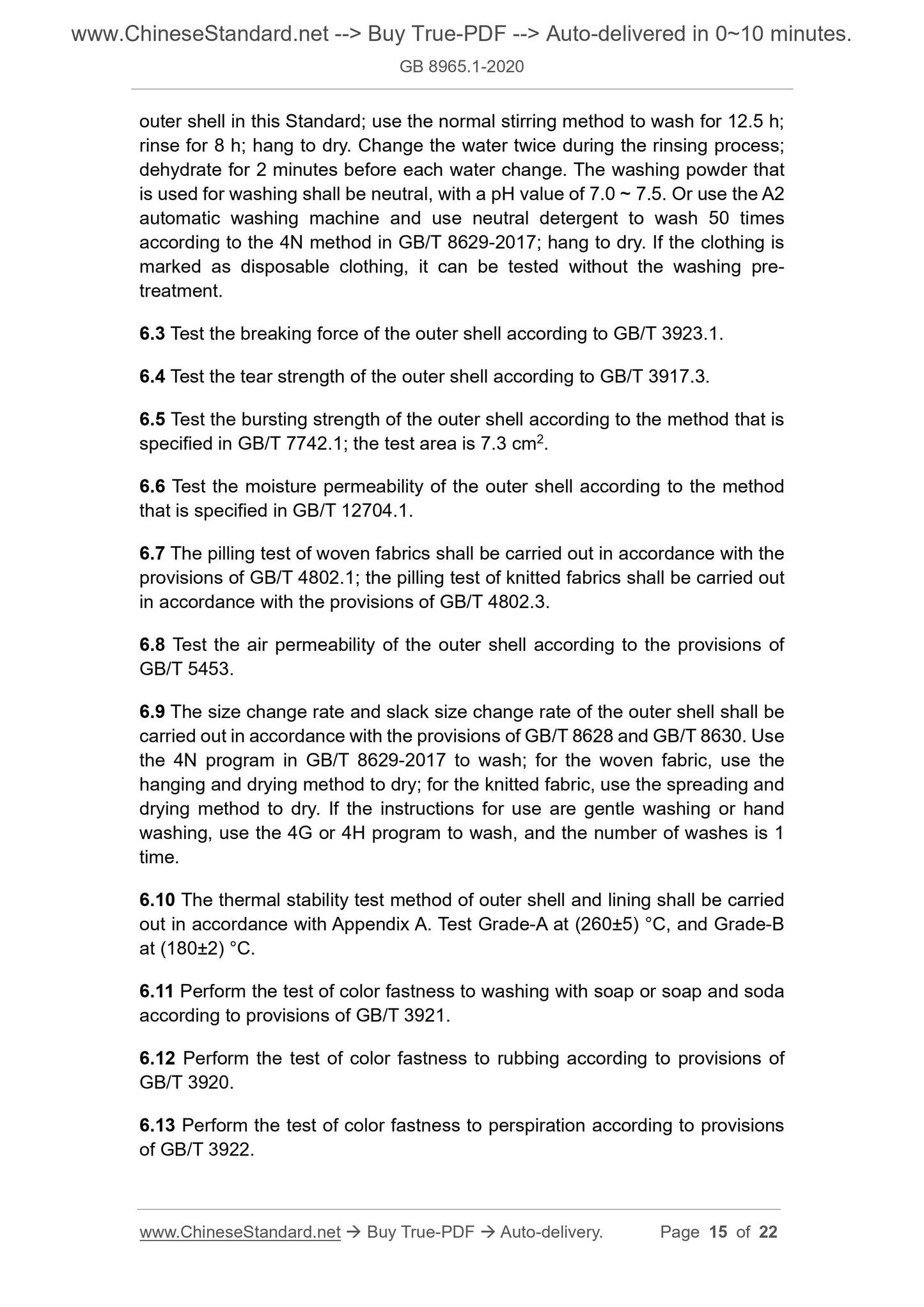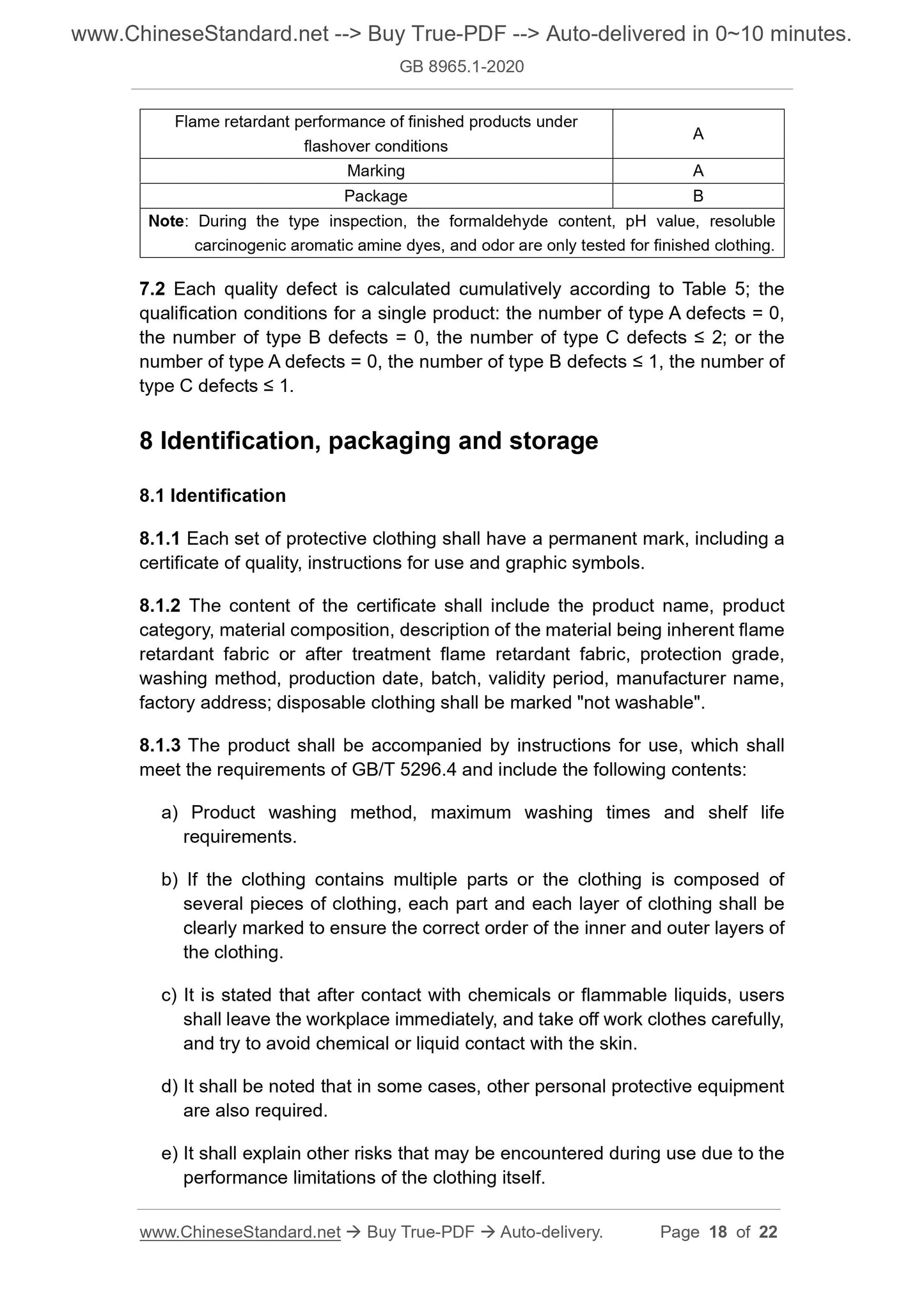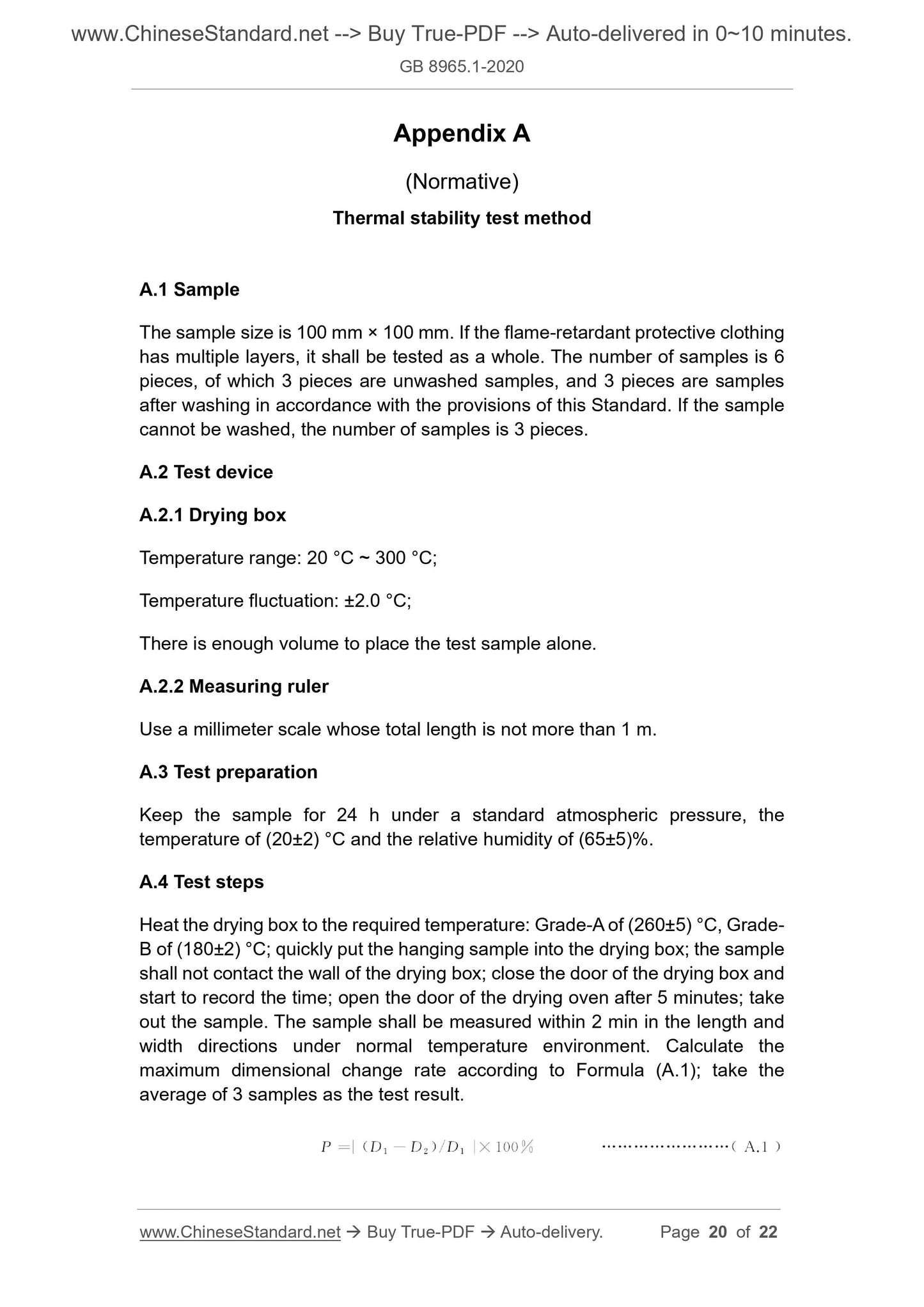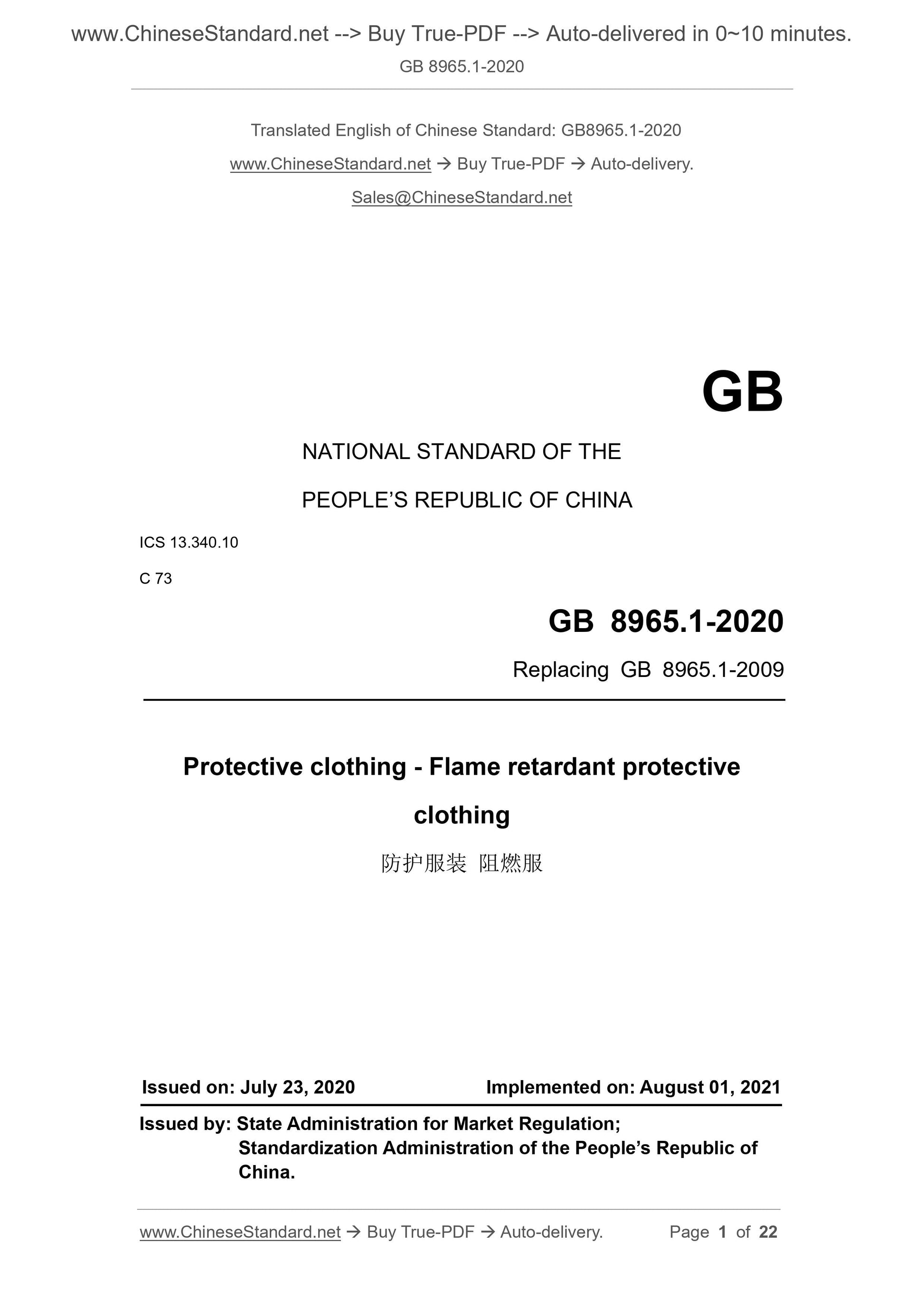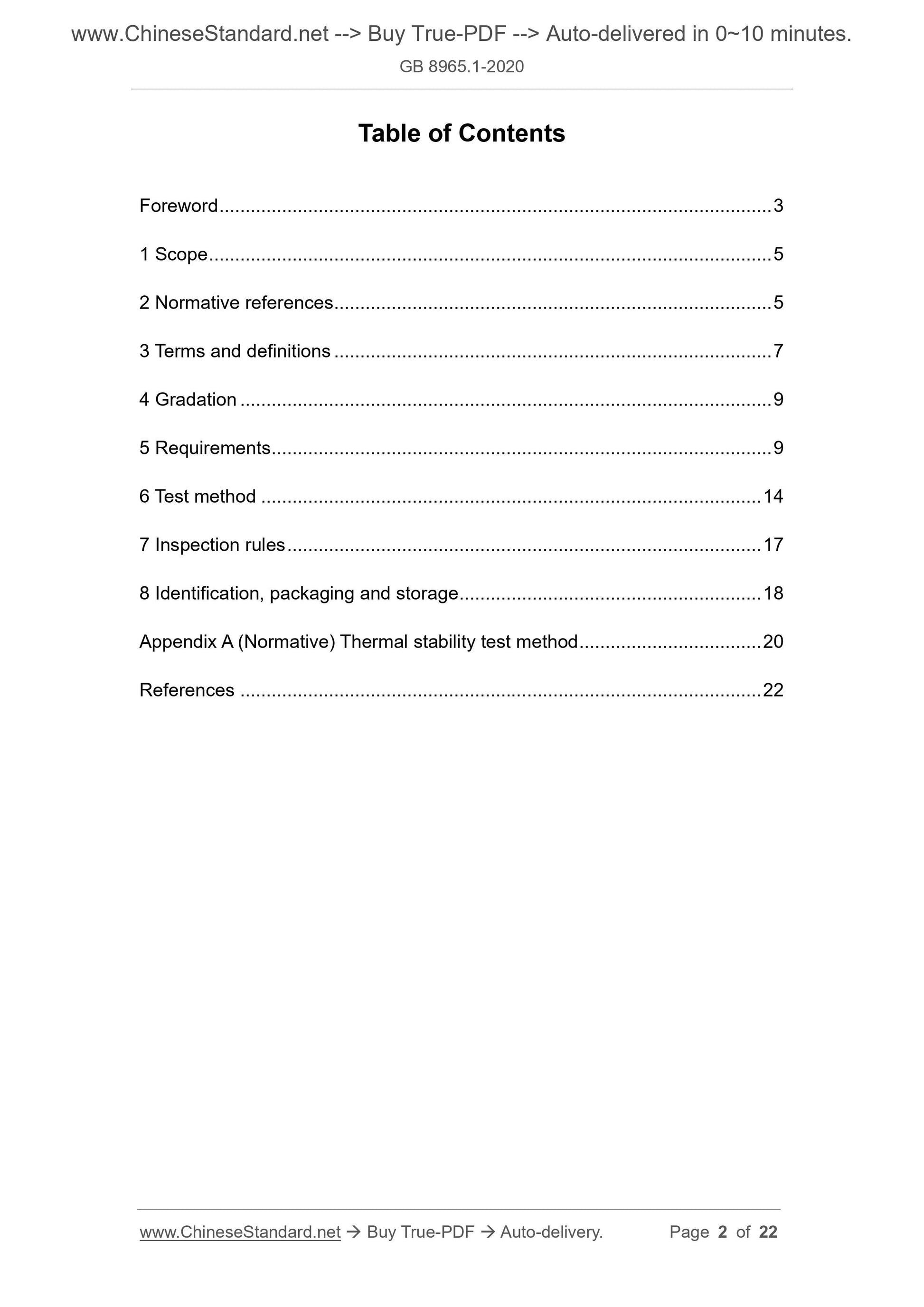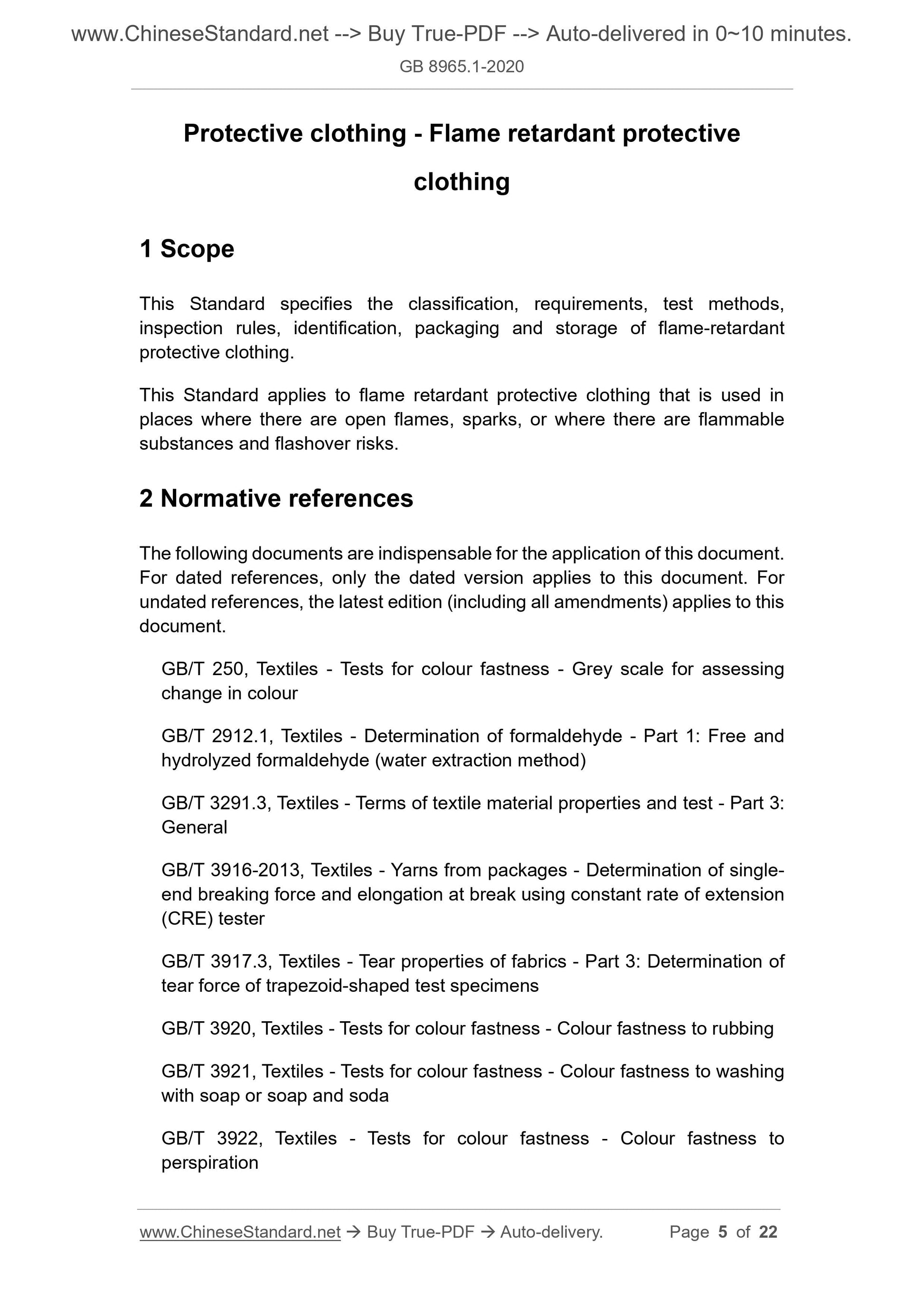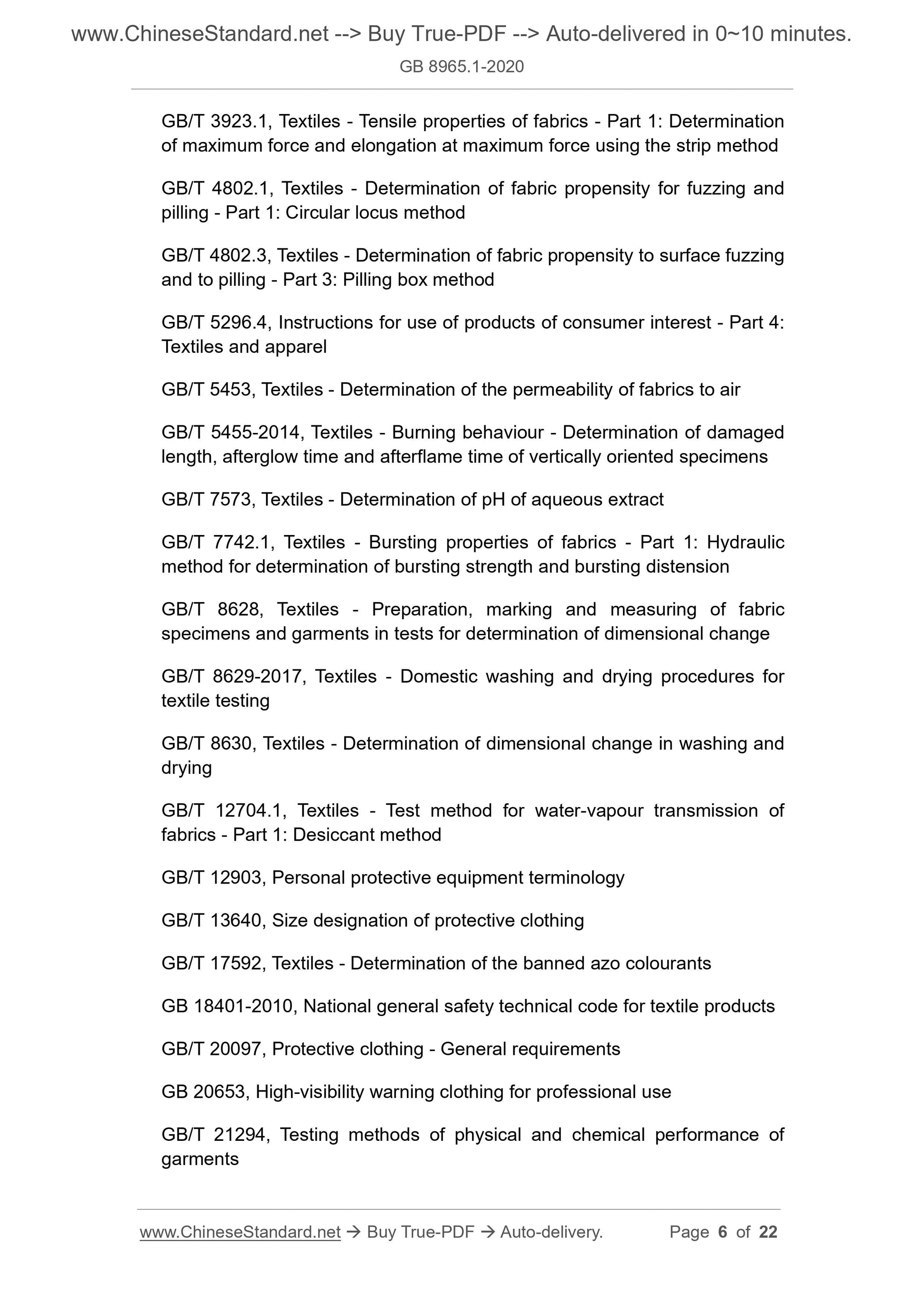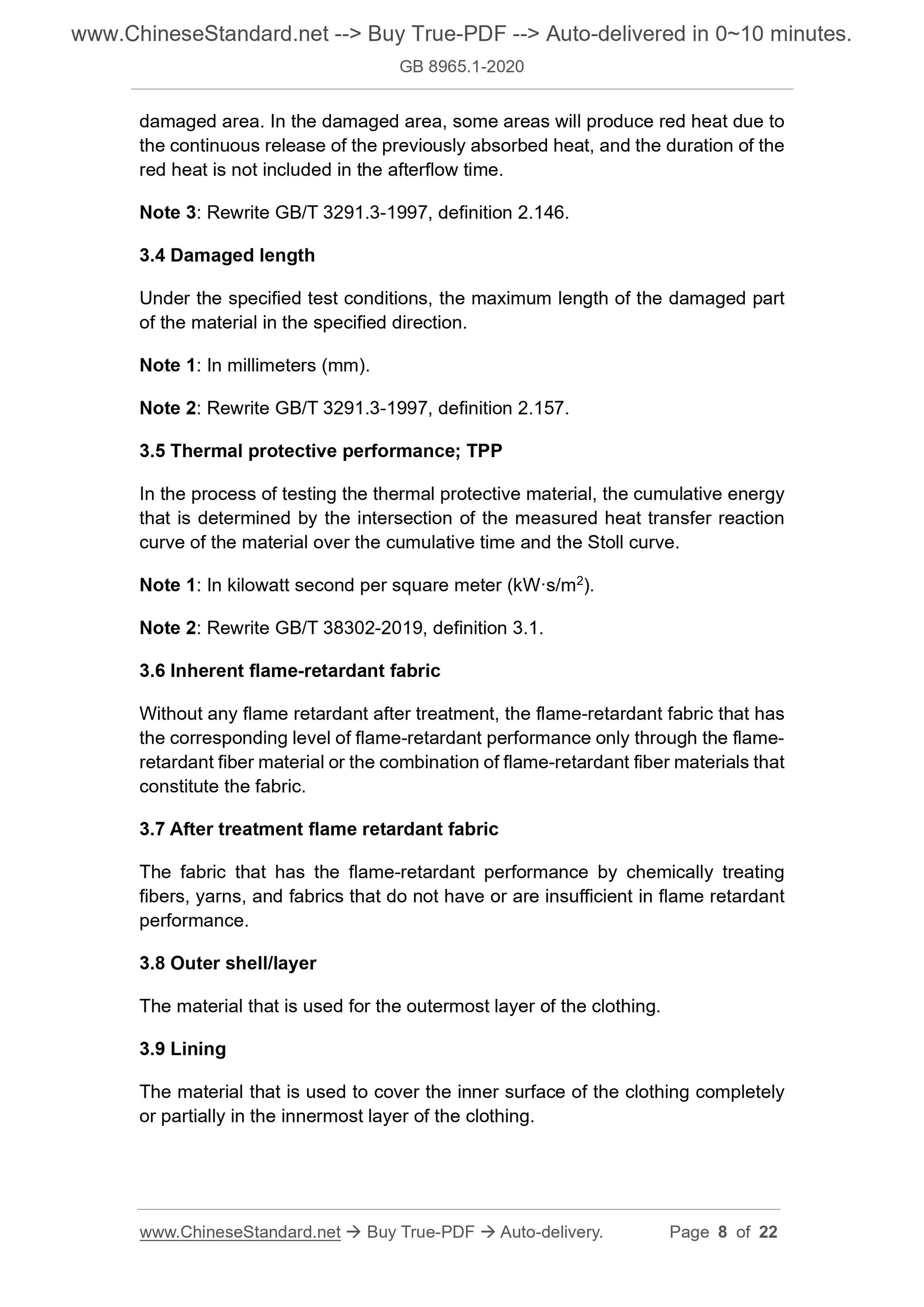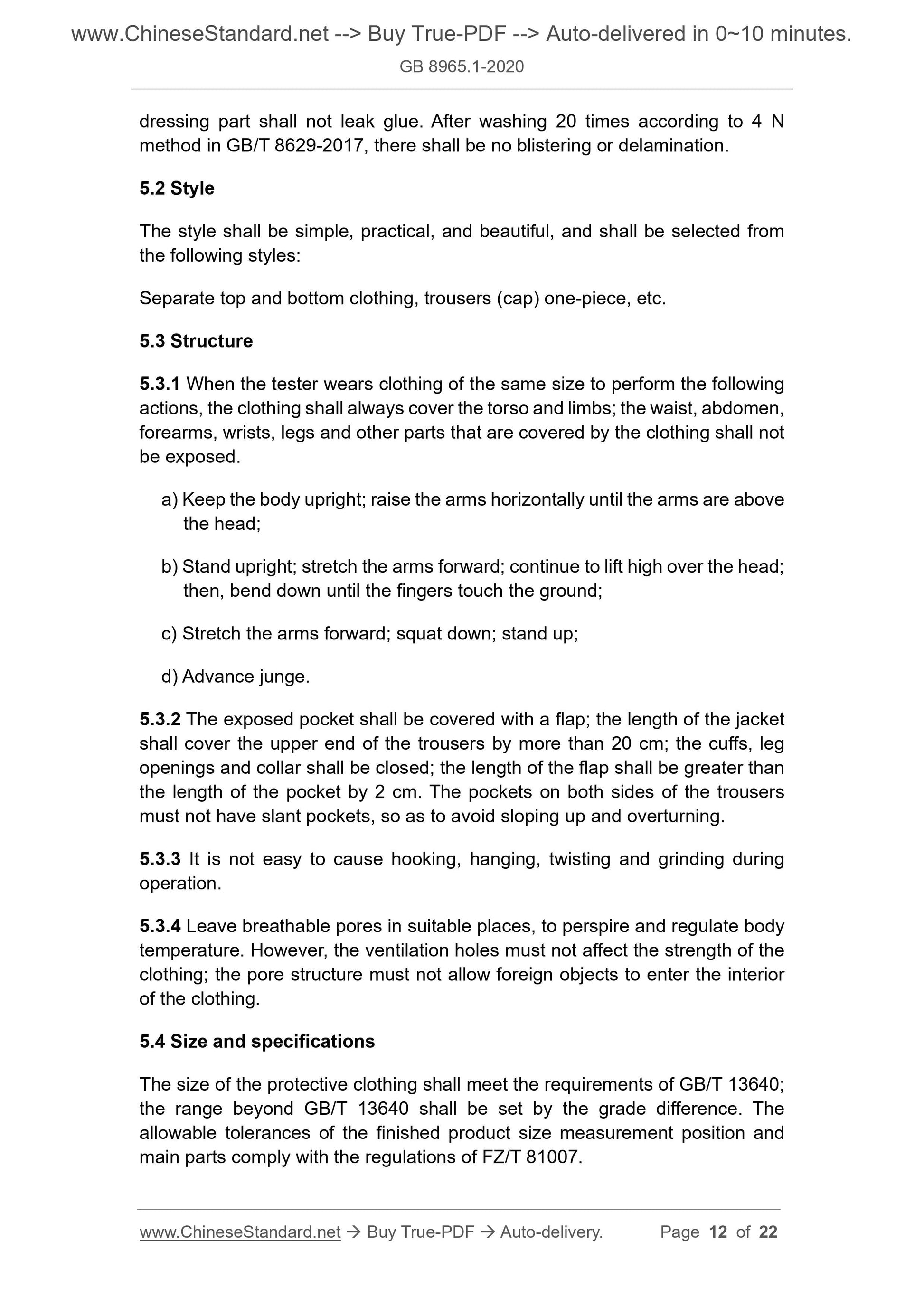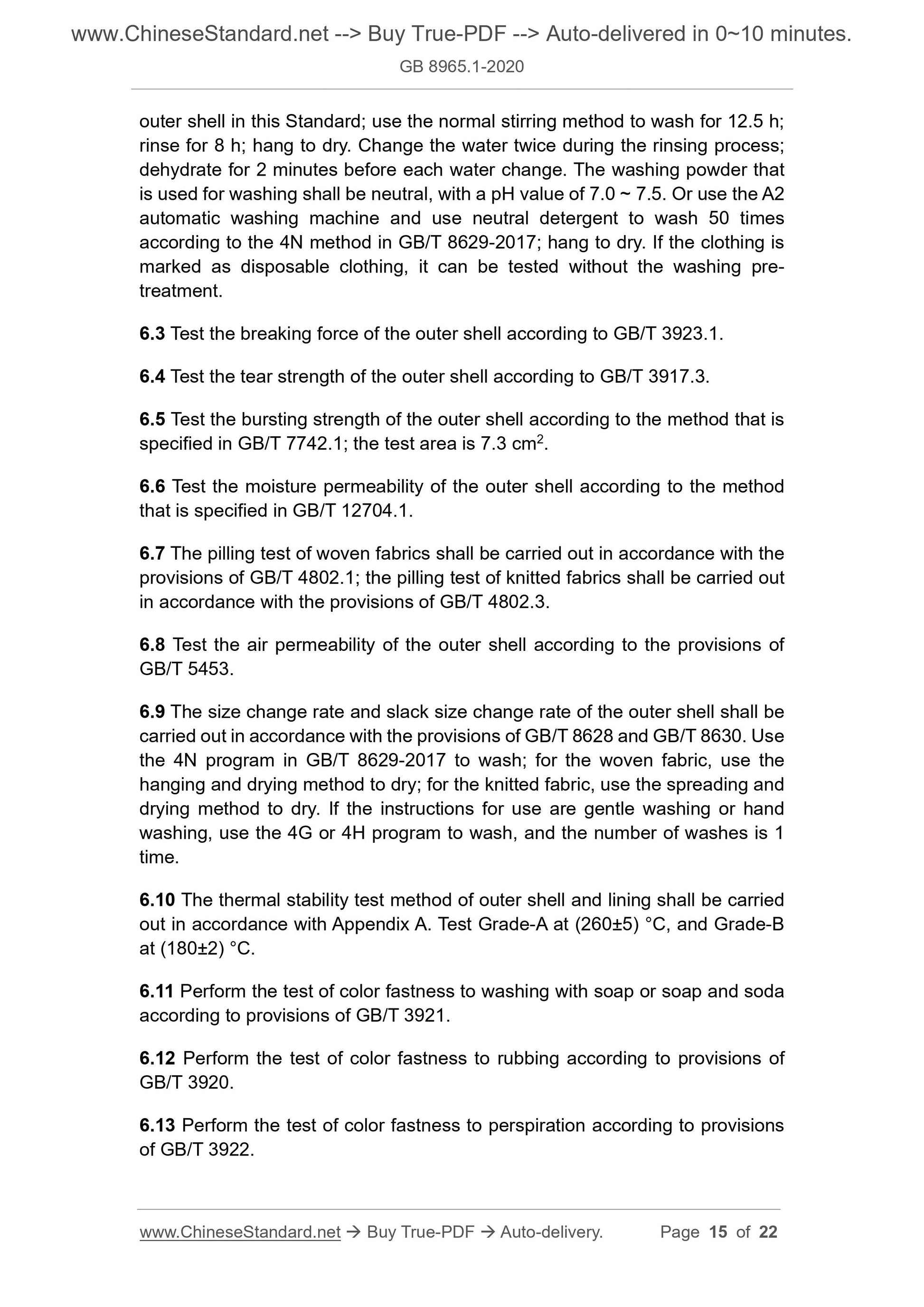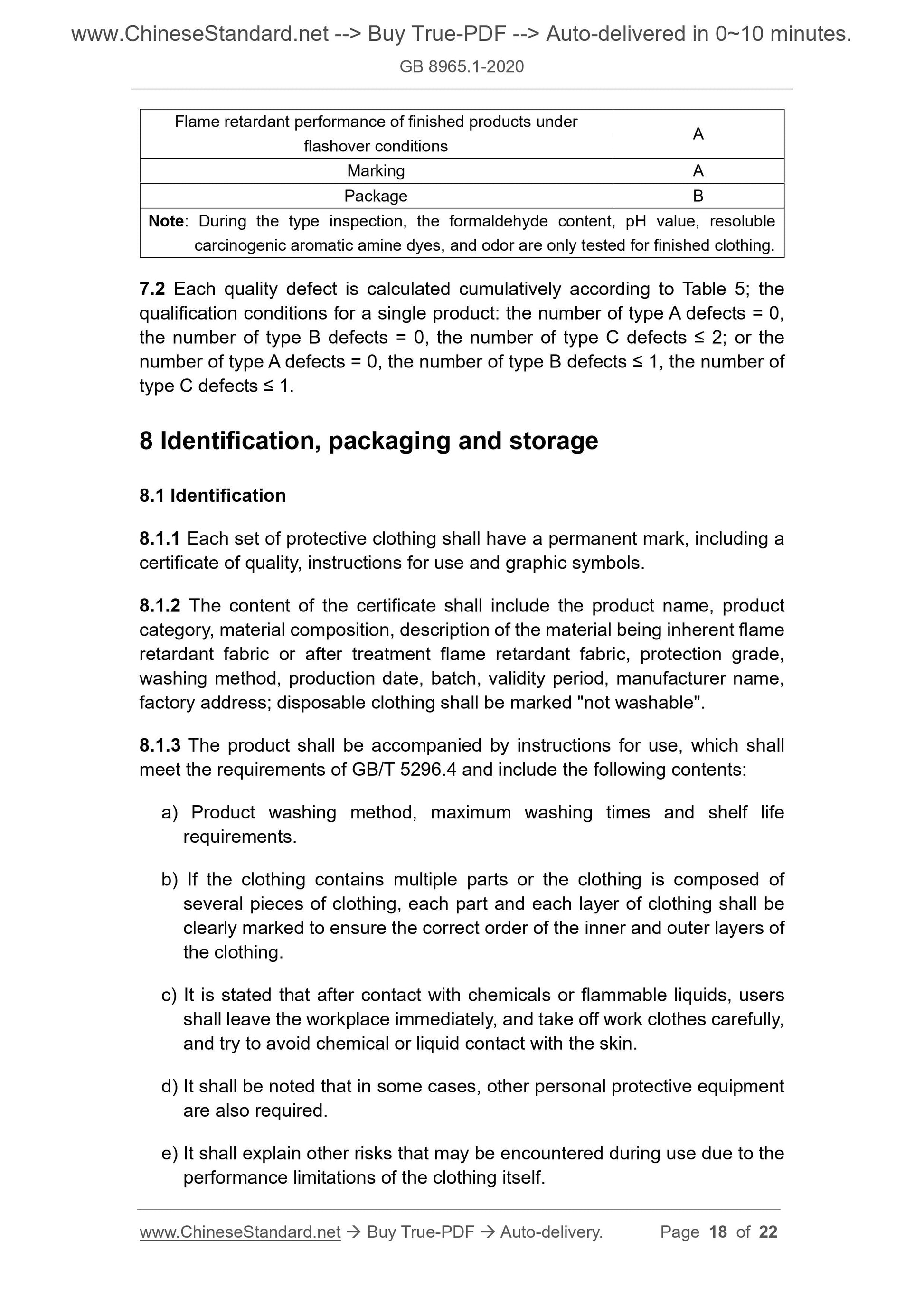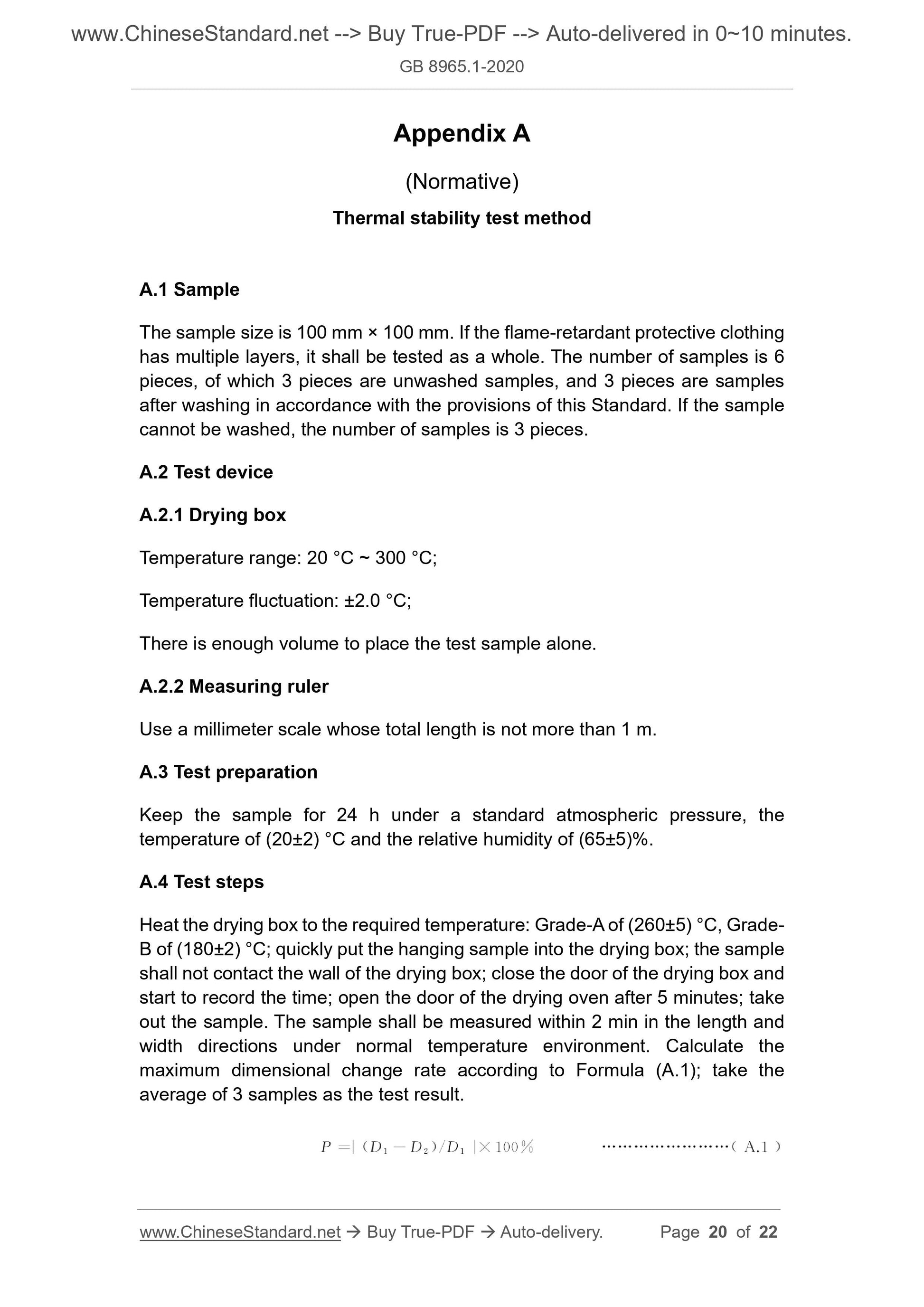PayPal, credit cards. Download editable-PDF & invoice in 1 second!
GB 8965.1-2020 English PDF (GB8965.1-2020)
GB 8965.1-2020 English PDF (GB8965.1-2020)
Precio habitual
$205.00 USD
Precio habitual
Precio de oferta
$205.00 USD
Precio unitario
/
por
Los gastos de envío se calculan en la pantalla de pago.
No se pudo cargar la disponibilidad de retiro
Delivery: 3 seconds. Download true-PDF + Invoice.
Get QUOTATION in 1-minute: Click GB 8965.1-2020
Historical versions: GB 8965.1-2020
Preview True-PDF (Reload/Scroll if blank)
GB 8965.1-2020: Protective clothing--Flame retardant protective clothing
GB 8965.1-2020
GB
NATIONAL STANDARD OF THE
PEOPLE’S REPUBLIC OF CHINA
ICS 13.340.10
C 73
Replacing GB 8965.1-2009
Protective clothing - Flame retardant protective
clothing
ISSUED ON: JULY 23, 2020
IMPLEMENTED ON: AUGUST 01, 2021
Issued by: State Administration for Market Regulation;
Standardization Administration of the People’s Republic of
China.
Table of Contents
Foreword ... 3
1 Scope ... 5
2 Normative references ... 5
3 Terms and definitions ... 7
4 Gradation ... 9
5 Requirements ... 9
6 Test method ... 14
7 Inspection rules ... 17
8 Identification, packaging and storage ... 18
Appendix A (Normative) Thermal stability test method ... 20
References ... 22
Protective clothing - Flame retardant protective
clothing
1 Scope
This Standard specifies the classification, requirements, test methods,
inspection rules, identification, packaging and storage of flame-retardant
protective clothing.
This Standard applies to flame retardant protective clothing that is used in
places where there are open flames, sparks, or where there are flammable
substances and flashover risks.
2 Normative references
The following documents are indispensable for the application of this document.
For dated references, only the dated version applies to this document. For
undated references, the latest edition (including all amendments) applies to this
document.
GB/T 250, Textiles - Tests for colour fastness - Grey scale for assessing
change in colour
GB/T 2912.1, Textiles - Determination of formaldehyde - Part 1: Free and
hydrolyzed formaldehyde (water extraction method)
GB/T 3291.3, Textiles - Terms of textile material properties and test - Part 3:
General
GB/T 3916-2013, Textiles - Yarns from packages - Determination of single-
end breaking force and elongation at break using constant rate of extension
(CRE) tester
GB/T 3917.3, Textiles - Tear properties of fabrics - Part 3: Determination of
tear force of trapezoid-shaped test specimens
GB/T 3920, Textiles - Tests for colour fastness - Colour fastness to rubbing
GB/T 3921, Textiles - Tests for colour fastness - Colour fastness to washing
with soap or soap and soda
GB/T 3922, Textiles - Tests for colour fastness - Colour fastness to
perspiration
GB/T 3923.1, Textiles - Tensile properties of fabrics - Part 1: Determination
of maximum force and elongation at maximum force using the strip method
GB/T 4802.1, Textiles - Determination of fabric propensity for fuzzing and
pilling - Part 1: Circular locus method
GB/T 4802.3, Textiles - Determination of fabric propensity to surface fuzzing
and to pilling - Part 3: Pilling box method
GB/T 5296.4, Instructions for use of products of consumer interest - Part 4:
Textiles and apparel
GB/T 5453, Textiles - Determination of the permeability of fabrics to air
GB/T 5455-2014, Textiles - Burning behaviour - Determination of damaged
length, afterglow time and afterflame time of vertically oriented specimens
GB/T 7573, Textiles - Determination of pH of aqueous extract
GB/T 7742.1, Textiles - Bursting properties of fabrics - Part 1: Hydraulic
method for determination of bursting strength and bursting distension
GB/T 8628, Textiles - Preparation, marking and measuring of fabric
specimens and garments in tests for determination of dimensional change
GB/T 8629-2017, Textiles - Domestic washing and drying procedures for
textile testing
GB/T 8630, Textiles - Determination of dimensional change in washing and
drying
GB/T 12704.1, Textiles - Test method for water-vapour transmission of
fabrics - Part 1: Desiccant method
GB/T 12903, Personal protective equipment terminology
GB/T 13640, Size designation of protective clothing
GB/T 17592, Textiles - Determination of the banned azo colourants
GB 18401-2010, National general safety technical code for textile products
GB/T 20097, Protective clothing - General requirements
GB 20653, High-visibility warning clothing for professional use
GB/T 21294, Testing methods of physical and chemical performance of
garments
damaged area. In the damaged area, some areas will produce red heat due to
the continuous release of the previously absorbed heat, and the duration of the
red heat is not included in the afterflow time.
Note 3: Rewrite GB/T 3291.3-1997, definition 2.146.
3.4 Damaged length
Under the specified test conditions, the maximum length of the damaged part
of the material in the specified direction.
Note 1: In millimeters (mm).
Note 2: Rewrite GB/T 3291.3-1997, definition 2.157.
3.5 Thermal protective performance; TPP
In the process of testing the thermal protective material, the cumulative energy
that is determined by the intersection of the measured heat transfer reaction
curve of the material over the cumulative time and the Stoll curve.
Note 1: In kilowatt second per square meter (kW·s/m2).
Note 2: Rewrite GB/T 38302-2019, definition 3.1.
3.6 Inherent flame-retardant fabric
Without any flame retardant after treatment, the flame-retardant fabric that has
the corresponding level of flame-retardant performance only through the flame-
retardant fiber material or the combination of flame-retardant fiber materials that
constitute the fabric.
3.7 After treatment flame retardant fabric
The fabric that has the flame-retardant performance by chemically treating
fibers, yarns, and fabrics that do not have or are insufficient in flame retardant
performance.
3.8 Outer shell/layer
The material that is used for the outermost layer of the clothing.
3.9 Lining
The material that is used to cover the inner surface of the clothing completely
or partially in the innermost layer of the clothing.
dressing part shall not leak glue. After washing 20 times according to 4 N
method in GB/T 8629-2017, there shall be no blistering or delamination.
5.2 Style
The style shall be simple, practical, and beautiful, and shall be selected from
the following styles:
Separate top and bottom clothing, trousers (cap) one-piece, etc.
5.3 Structure
5.3.1 When the tester wears clothing of the same size to perform the following
actions, the clothing shall always cover the torso and limbs; the waist, abdomen,
forearms, wrists, legs and other parts that are covered by the clothing shall not
be exposed.
a) Keep the body upright; raise the arms horizontally until the arms are above
the head;
b) Stand upright; stretch the arms forward; continue to lift high over the head;
then, bend down until the fingers touch the ground;
c) Stretch the arms forward; squat down; stand up;
d) Advance junge.
5.3.2 The exposed pocket shall be covered with a flap; the length of the jacket
shall cover the upper end of the trousers by more than 20 cm; the cuffs, leg
openings and collar shall be closed; the length of the flap shall be greater than
the length of the pocket by 2 cm. The pockets on both sides of the trousers
must not have slant pockets, so as to avoid sloping up and overturning.
5.3.3 It is not easy to cause hooking, hanging, twisting and grinding during
operation.
5.3.4 Leave breathable pores in suitable places, to perspire and regulate body
temperature. However, the ventilation holes must not affect the strength of the
clothing; the pore structure must not allow foreign objects to enter the interior
of the clothing.
5.4 Size and specifications
The size of the protective clothing shall meet the requir...
Get QUOTATION in 1-minute: Click GB 8965.1-2020
Historical versions: GB 8965.1-2020
Preview True-PDF (Reload/Scroll if blank)
GB 8965.1-2020: Protective clothing--Flame retardant protective clothing
GB 8965.1-2020
GB
NATIONAL STANDARD OF THE
PEOPLE’S REPUBLIC OF CHINA
ICS 13.340.10
C 73
Replacing GB 8965.1-2009
Protective clothing - Flame retardant protective
clothing
ISSUED ON: JULY 23, 2020
IMPLEMENTED ON: AUGUST 01, 2021
Issued by: State Administration for Market Regulation;
Standardization Administration of the People’s Republic of
China.
Table of Contents
Foreword ... 3
1 Scope ... 5
2 Normative references ... 5
3 Terms and definitions ... 7
4 Gradation ... 9
5 Requirements ... 9
6 Test method ... 14
7 Inspection rules ... 17
8 Identification, packaging and storage ... 18
Appendix A (Normative) Thermal stability test method ... 20
References ... 22
Protective clothing - Flame retardant protective
clothing
1 Scope
This Standard specifies the classification, requirements, test methods,
inspection rules, identification, packaging and storage of flame-retardant
protective clothing.
This Standard applies to flame retardant protective clothing that is used in
places where there are open flames, sparks, or where there are flammable
substances and flashover risks.
2 Normative references
The following documents are indispensable for the application of this document.
For dated references, only the dated version applies to this document. For
undated references, the latest edition (including all amendments) applies to this
document.
GB/T 250, Textiles - Tests for colour fastness - Grey scale for assessing
change in colour
GB/T 2912.1, Textiles - Determination of formaldehyde - Part 1: Free and
hydrolyzed formaldehyde (water extraction method)
GB/T 3291.3, Textiles - Terms of textile material properties and test - Part 3:
General
GB/T 3916-2013, Textiles - Yarns from packages - Determination of single-
end breaking force and elongation at break using constant rate of extension
(CRE) tester
GB/T 3917.3, Textiles - Tear properties of fabrics - Part 3: Determination of
tear force of trapezoid-shaped test specimens
GB/T 3920, Textiles - Tests for colour fastness - Colour fastness to rubbing
GB/T 3921, Textiles - Tests for colour fastness - Colour fastness to washing
with soap or soap and soda
GB/T 3922, Textiles - Tests for colour fastness - Colour fastness to
perspiration
GB/T 3923.1, Textiles - Tensile properties of fabrics - Part 1: Determination
of maximum force and elongation at maximum force using the strip method
GB/T 4802.1, Textiles - Determination of fabric propensity for fuzzing and
pilling - Part 1: Circular locus method
GB/T 4802.3, Textiles - Determination of fabric propensity to surface fuzzing
and to pilling - Part 3: Pilling box method
GB/T 5296.4, Instructions for use of products of consumer interest - Part 4:
Textiles and apparel
GB/T 5453, Textiles - Determination of the permeability of fabrics to air
GB/T 5455-2014, Textiles - Burning behaviour - Determination of damaged
length, afterglow time and afterflame time of vertically oriented specimens
GB/T 7573, Textiles - Determination of pH of aqueous extract
GB/T 7742.1, Textiles - Bursting properties of fabrics - Part 1: Hydraulic
method for determination of bursting strength and bursting distension
GB/T 8628, Textiles - Preparation, marking and measuring of fabric
specimens and garments in tests for determination of dimensional change
GB/T 8629-2017, Textiles - Domestic washing and drying procedures for
textile testing
GB/T 8630, Textiles - Determination of dimensional change in washing and
drying
GB/T 12704.1, Textiles - Test method for water-vapour transmission of
fabrics - Part 1: Desiccant method
GB/T 12903, Personal protective equipment terminology
GB/T 13640, Size designation of protective clothing
GB/T 17592, Textiles - Determination of the banned azo colourants
GB 18401-2010, National general safety technical code for textile products
GB/T 20097, Protective clothing - General requirements
GB 20653, High-visibility warning clothing for professional use
GB/T 21294, Testing methods of physical and chemical performance of
garments
damaged area. In the damaged area, some areas will produce red heat due to
the continuous release of the previously absorbed heat, and the duration of the
red heat is not included in the afterflow time.
Note 3: Rewrite GB/T 3291.3-1997, definition 2.146.
3.4 Damaged length
Under the specified test conditions, the maximum length of the damaged part
of the material in the specified direction.
Note 1: In millimeters (mm).
Note 2: Rewrite GB/T 3291.3-1997, definition 2.157.
3.5 Thermal protective performance; TPP
In the process of testing the thermal protective material, the cumulative energy
that is determined by the intersection of the measured heat transfer reaction
curve of the material over the cumulative time and the Stoll curve.
Note 1: In kilowatt second per square meter (kW·s/m2).
Note 2: Rewrite GB/T 38302-2019, definition 3.1.
3.6 Inherent flame-retardant fabric
Without any flame retardant after treatment, the flame-retardant fabric that has
the corresponding level of flame-retardant performance only through the flame-
retardant fiber material or the combination of flame-retardant fiber materials that
constitute the fabric.
3.7 After treatment flame retardant fabric
The fabric that has the flame-retardant performance by chemically treating
fibers, yarns, and fabrics that do not have or are insufficient in flame retardant
performance.
3.8 Outer shell/layer
The material that is used for the outermost layer of the clothing.
3.9 Lining
The material that is used to cover the inner surface of the clothing completely
or partially in the innermost layer of the clothing.
dressing part shall not leak glue. After washing 20 times according to 4 N
method in GB/T 8629-2017, there shall be no blistering or delamination.
5.2 Style
The style shall be simple, practical, and beautiful, and shall be selected from
the following styles:
Separate top and bottom clothing, trousers (cap) one-piece, etc.
5.3 Structure
5.3.1 When the tester wears clothing of the same size to perform the following
actions, the clothing shall always cover the torso and limbs; the waist, abdomen,
forearms, wrists, legs and other parts that are covered by the clothing shall not
be exposed.
a) Keep the body upright; raise the arms horizontally until the arms are above
the head;
b) Stand upright; stretch the arms forward; continue to lift high over the head;
then, bend down until the fingers touch the ground;
c) Stretch the arms forward; squat down; stand up;
d) Advance junge.
5.3.2 The exposed pocket shall be covered with a flap; the length of the jacket
shall cover the upper end of the trousers by more than 20 cm; the cuffs, leg
openings and collar shall be closed; the length of the flap shall be greater than
the length of the pocket by 2 cm. The pockets on both sides of the trousers
must not have slant pockets, so as to avoid sloping up and overturning.
5.3.3 It is not easy to cause hooking, hanging, twisting and grinding during
operation.
5.3.4 Leave breathable pores in suitable places, to perspire and regulate body
temperature. However, the ventilation holes must not affect the strength of the
clothing; the pore structure must not allow foreign objects to enter the interior
of the clothing.
5.4 Size and specifications
The size of the protective clothing shall meet the requir...
Share
